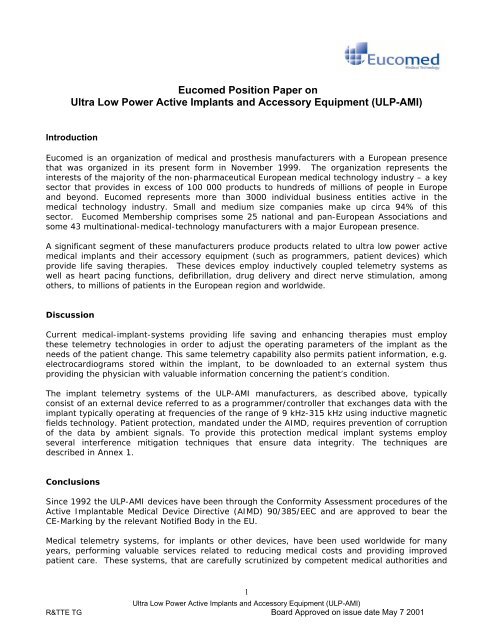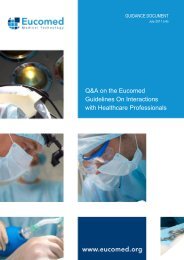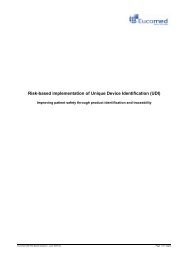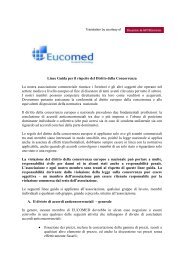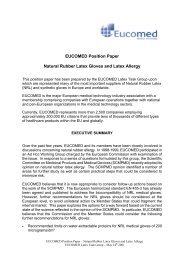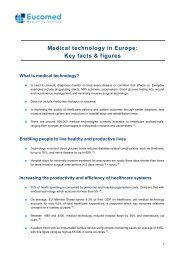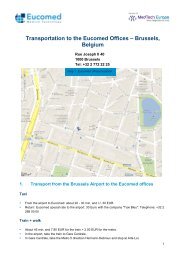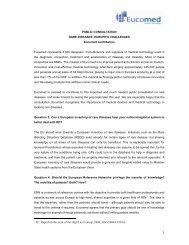Eucomed Position Paper on Ultra Low Power Active Implants and ...
Eucomed Position Paper on Ultra Low Power Active Implants and ...
Eucomed Position Paper on Ultra Low Power Active Implants and ...
Create successful ePaper yourself
Turn your PDF publications into a flip-book with our unique Google optimized e-Paper software.
<str<strong>on</strong>g>Eucomed</str<strong>on</strong>g> <str<strong>on</strong>g>Positi<strong>on</strong></str<strong>on</strong>g> <str<strong>on</strong>g>Paper</str<strong>on</strong>g> <strong>on</strong><br />
<strong>Ultra</strong> <strong>Low</strong> <strong>Power</strong> <strong>Active</strong> <strong>Implants</strong> <strong>and</strong> Accessory Equipment (ULP-AMI)<br />
Introducti<strong>on</strong><br />
<str<strong>on</strong>g>Eucomed</str<strong>on</strong>g> is an organizati<strong>on</strong> of medical <strong>and</strong> prosthesis manufacturers with a European presence<br />
that was organized in its present form in November 1999. The organizati<strong>on</strong> represents the<br />
interests of the majority of the n<strong>on</strong>-pharmaceutical European medical technology industry – a key<br />
sector that provides in excess of 100 000 products to hundreds of milli<strong>on</strong>s of people in Europe<br />
<strong>and</strong> bey<strong>on</strong>d. <str<strong>on</strong>g>Eucomed</str<strong>on</strong>g> represents more than 3000 individual business entities active in the<br />
medical technology industry. Small <strong>and</strong> medium size companies make up circa 94% of this<br />
sector. <str<strong>on</strong>g>Eucomed</str<strong>on</strong>g> Membership comprises some 25 nati<strong>on</strong>al <strong>and</strong> pan-European Associati<strong>on</strong>s <strong>and</strong><br />
some 43 multinati<strong>on</strong>al-medical-technology manufacturers with a major European presence.<br />
A significant segment of these manufacturers produce products related to ultra low power active<br />
medical implants <strong>and</strong> their accessory equipment (such as programmers, patient devices) which<br />
provide life saving therapies. These devices employ inductively coupled telemetry systems as<br />
well as heart pacing functi<strong>on</strong>s, defibrillati<strong>on</strong>, drug delivery <strong>and</strong> direct nerve stimulati<strong>on</strong>, am<strong>on</strong>g<br />
others, to milli<strong>on</strong>s of patients in the European regi<strong>on</strong> <strong>and</strong> worldwide.<br />
Discussi<strong>on</strong><br />
Current medical-implant-systems providing life saving <strong>and</strong> enhancing therapies must employ<br />
these telemetry technologies in order to adjust the operating parameters of the implant as the<br />
needs of the patient change. This same telemetry capability also permits patient informati<strong>on</strong>, e.g.<br />
electrocardiograms stored within the implant, to be downloaded to an external system thus<br />
providing the physician with valuable informati<strong>on</strong> c<strong>on</strong>cerning the patient’s c<strong>on</strong>diti<strong>on</strong>.<br />
The implant telemetry systems of the ULP-AMI manufacturers, as described above, typically<br />
c<strong>on</strong>sist of an external device referred to as a programmer/c<strong>on</strong>troller that exchanges data with the<br />
implant typically operating at frequencies of the range of 9 kHz-315 kHz using inductive magnetic<br />
fields technology. Patient protecti<strong>on</strong>, m<strong>and</strong>ated under the AIMD, requires preventi<strong>on</strong> of corrupti<strong>on</strong><br />
of the data by ambient signals. To provide this protecti<strong>on</strong> medical implant systems employ<br />
several interference mitigati<strong>on</strong> techniques that ensure data integrity. The techniques are<br />
described in Annex 1.<br />
C<strong>on</strong>clusi<strong>on</strong>s<br />
Since 1992 the ULP-AMI devices have been through the C<strong>on</strong>formity Assessment procedures of the<br />
<strong>Active</strong> Implantable Medical Device Directive (AIMD) 90/385/EEC <strong>and</strong> are approved to bear the<br />
CE-Marking by the relevant Notified Body in the EU.<br />
Medical telemetry systems, for implants or other devices, have been used worldwide for many<br />
years, performing valuable services related to reducing medical costs <strong>and</strong> providing improved<br />
patient care. These systems, that are carefully scrutinized by competent medical authorities <strong>and</strong><br />
<strong>Ultra</strong> <strong>Low</strong> <strong>Power</strong> <strong>Active</strong> <strong>Implants</strong> <strong>and</strong> Accessory Equipment (ULP-AMI)<br />
R&TTE TG Board Approved <strong>on</strong> issue date May 7 2001<br />
1
are subject to applicable st<strong>and</strong>ards imposed by the medical authorities that m<strong>and</strong>ate patient<br />
safety, must be protected above all else. This is also emphasized in the R&TTE directive: “without<br />
prejudice to the applicati<strong>on</strong> of Directives 93/42/EEC <strong>and</strong> 90/385/EEC to medical devices <strong>and</strong><br />
active implantable medical devices, respectively.”<br />
One example of such a st<strong>and</strong>ard in Europe, is EN 60601-1-4 Medical Electrical equipment, Part 1.<br />
General requirements for safety, Secti<strong>on</strong> 1.4 Collateral st<strong>and</strong>ard: General requirements for<br />
programmable electrical medical systems. This specifically states in sub-clause 52.204.3.1.6 that<br />
data protecti<strong>on</strong> from human intenti<strong>on</strong>al or unintenti<strong>on</strong>al causes must be satisfactorily addressed<br />
in the hazard analysis in the governing st<strong>and</strong>ard. The hazard analysis is reviewed by the<br />
governing medical authorities for acceptability in showing that the data is protected from<br />
corrupti<strong>on</strong>. Other st<strong>and</strong>ards are also used to meet these requirements. The medical community<br />
itself can attest to the adequacy of the above techniques in ensuring system design prevents<br />
ambient signals from interfering with these telemetry systems.<br />
The magnetic field strengths from the ULP-AMI are well below the levels specified in EN 300 330<br />
as well as the limits of applicable EMC St<strong>and</strong>ards.<br />
The z<strong>on</strong>e of influence <strong>and</strong> periodicity of signals transmitted from these systems is very small due<br />
to their very low power, low duty cycle, frequency of operati<strong>on</strong>, <strong>and</strong> the rapid attenuati<strong>on</strong> rate as<br />
a functi<strong>on</strong> of distance. Because of these factors, these systems pose no threat of harmful<br />
interference to existing users of the spectrum<br />
Reiterating, the above processes <strong>and</strong> technical design characteristics ensure that these medical<br />
systems will not cause harmful interference to the existing broadcasters, that the primary status<br />
broadcasters will not cause interference to the medical systems <strong>and</strong> that the patient’s safety is<br />
always assured.<br />
Proposal<br />
With the above in mind, it is the c<strong>on</strong>sidered opini<strong>on</strong> of <str<strong>on</strong>g>Eucomed</str<strong>on</strong>g> to seek an appropriate soluti<strong>on</strong><br />
by extending ANNEX 12 of CEPT/ERC/Rec 70-03 with the following frequency b<strong>and</strong>s for use<br />
specifically by active medical implants <strong>and</strong> programmer/c<strong>on</strong>trollers in the range of 9 kHz up to<br />
315 kHz:<br />
a) 9 kHz – 135 kHz<br />
b) 135 kHz – 148,5 kHz<br />
c) 148,5 kHz – 255 kHz<br />
d) 255 kHz – 283,5 kHz<br />
e) 283,5 kHz - 315 kHz<br />
Therefore <str<strong>on</strong>g>Eucomed</str<strong>on</strong>g> is kindly asking the Short Range Device Management Group to c<strong>on</strong>sider:<br />
1) Adopting, under Annex 12 of CEPT/ERC/Rec 70-03, the above stated frequency b<strong>and</strong>s<br />
specifically for low frequency, low power, inductively coupled active medical implant telemetry<br />
systems that have been used for many years by this branch of the medical manufacturing<br />
industry.<br />
2) C<strong>on</strong>currently with this request, we urge the appropriate authorities to c<strong>on</strong>sider including this<br />
b<strong>and</strong> in the framework of a Decisi<strong>on</strong>s Status if at all possible.<br />
3) There should be no licensing requirements for the use of these ULP-AMI devices <strong>and</strong> their<br />
accessory equipment.<br />
<strong>Ultra</strong> <strong>Low</strong> <strong>Power</strong> <strong>Active</strong> <strong>Implants</strong> <strong>and</strong> Accessory Equipment (ULP-AMI)<br />
R&TTE TG Board Approved <strong>on</strong> issue date May 7 2001<br />
2
Annex to <str<strong>on</strong>g>Eucomed</str<strong>on</strong>g> <str<strong>on</strong>g>Positi<strong>on</strong></str<strong>on</strong>g> <str<strong>on</strong>g>Paper</str<strong>on</strong>g> <strong>on</strong> <strong>Ultra</strong> <strong>Low</strong> <strong>Power</strong> <strong>Active</strong> Implantable Medical Devices<br />
<strong>and</strong> Accessory Equipment (ULP-AMI)<br />
Patient protecti<strong>on</strong>, m<strong>and</strong>ated under the AIMD, requires preventi<strong>on</strong> of data corrupti<strong>on</strong> by ambient<br />
signals. To provide this protecti<strong>on</strong>, medical implant systems employ several techniques that protect<br />
the integrity of transmitted data. These techniques are described below:<br />
PROGRAMMER/CONTROLLER<br />
Programmer/C<strong>on</strong>trollers utilize a number of methods for reducing the levels of interference. Some<br />
examples of such methods are:<br />
1. The programmer/c<strong>on</strong>troller head is fully enclosed in a c<strong>on</strong>ductive shield that provides excellent<br />
isolati<strong>on</strong> to electric fields.<br />
2. The programmer/c<strong>on</strong>troller head often incorporates a dual opposing coil design that cancels<br />
out interference sources that are more than a few feet away. In additi<strong>on</strong>, the programming<br />
informati<strong>on</strong> transmitted to the implant is encoded with effective error code protecti<strong>on</strong>.<br />
3. Further, the valid comm<strong>and</strong> set utilized by the programmer is very limited. Thus, even if the<br />
implant did receive <strong>and</strong> decode a packet c<strong>on</strong>taining an error, the demodulated comm<strong>and</strong><br />
would not match a valid comm<strong>and</strong> that the implant is capable of recognizing.<br />
IMPLANT<br />
1. <strong>Implants</strong> require an external stimulus from a specific programmer with a unique signal code to<br />
activate their data exchange (telemetry) circuits. This stimulus can include a str<strong>on</strong>g external<br />
permanent magnet that closes an internal magnetic switch c<strong>on</strong>tained in the implant. Once the<br />
implant is activated the programmer/c<strong>on</strong>troller will validate the device identificati<strong>on</strong> informati<strong>on</strong><br />
<strong>and</strong> open a programming sessi<strong>on</strong>. During this programming sessi<strong>on</strong> all data packets<br />
generated by the implant or the programmer/c<strong>on</strong>troller are effectively encoded to make certain<br />
the decoded data is error free. Thus, a corrupted comm<strong>and</strong> that passes the CRC check will<br />
not be recognized by the implant.<br />
2. <strong>Implants</strong> are fully enclosed in a n<strong>on</strong>-ferrous metallic shield exclusive of the leads associated<br />
with implant functi<strong>on</strong>. These leads enter through individual chambers within the implant case<br />
<strong>and</strong> use low-pass filters which will effectively c<strong>on</strong>trol the coupling of any signal into the implant<br />
sufficiently that no threat to the normal performance of the implant exists.<br />
<strong>Ultra</strong> <strong>Low</strong> <strong>Power</strong> <strong>Active</strong> <strong>Implants</strong> <strong>and</strong> Accessory Equipment (ULP-AMI)<br />
R&TTE TG Board Approved <strong>on</strong> issue date May 7 2001<br />
3


